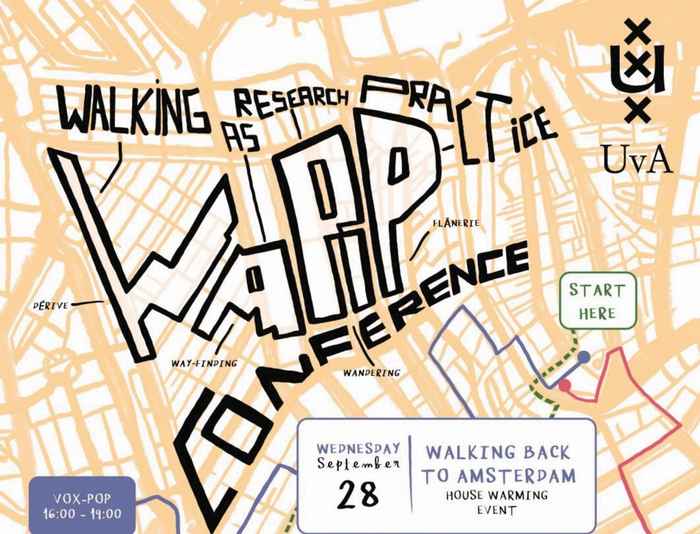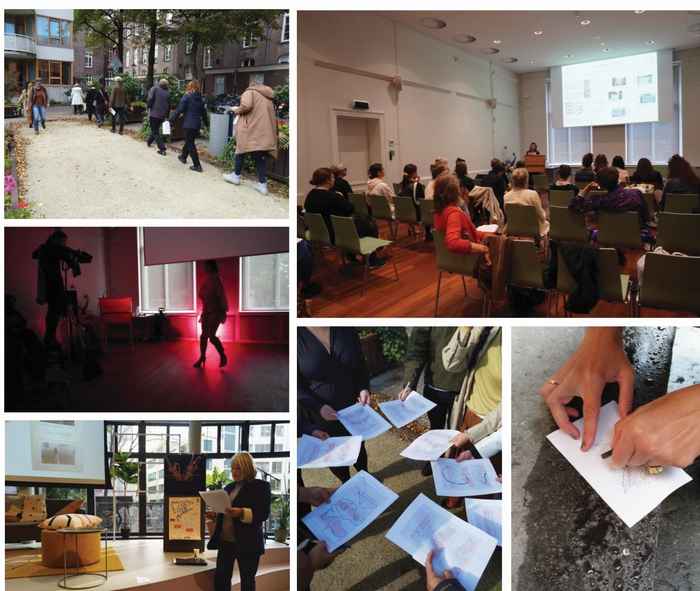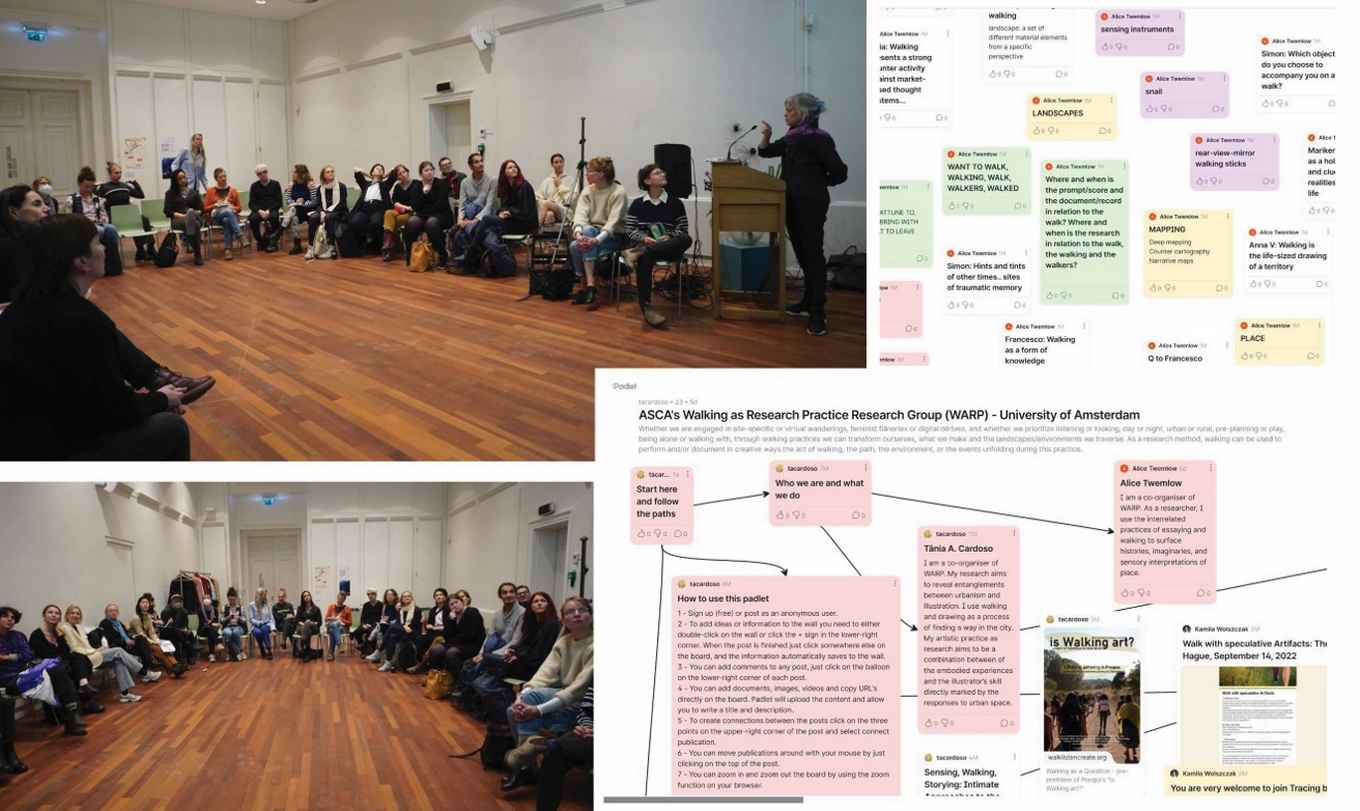Paving the way to creative urban practices: Walking as Research Practice (WARP) Conference
by Tânia Alexandra Cardoso
International participants from different fields and audiences have enriched the discussion of walking methodologies with new voices and perspectives throughout the two conference days (September 29-30, 2022). Together we tested out the different walking practices integrated into the fabric of the Conference, making it truly a hybrid experience, half conventionally presentation-based, half practice-based. This hybridity was achieved by combining conventional long and short presentations (posters, videos, performances, and soundwalks) and walkshops into the Conference program. These were organised into eight panels, a keynote lecture, a keynote walking seminar, and a plenary session. Through this format, we aimed to invite experimentation and foster collaboration between researchers and practitioners in urban studies, geography, artistic research, culture studies, and ethnography.
Walking is used increasingly in different fields. Researchers seek more diverse, accountable, and embodied research practices with the potential to explore and address pressing issues such as climate change, decolonisation, and gentrification. During the Conference, the participants were invited to share their relationship to walking, reflecting on how to engage meaningfully with its methods and concepts to reclaim the urban commons.
The results were productive experimentations and thoughtful insights into walking methodologies unrelated to specific outcomes. There was constant discussion and critical questioning about the advantages and limitations of walking as a research tool having the city of Amsterdam in the foreground. Responding to a growing interest in how walking practices relate to the body, the senses, placemaking, and becoming, the Conference connected participants and audiences in dialogue regarding emergent urban issues focusing on more sustainable and just spatial experiences.
The Conference started by discussing the role and impact of walking in the landscape as a tool for knowledge production and resistance in Un)Walking and (Un)Mapping Landscapes — a way of being, recollecting with, and becoming-with nature in a permanently ongoing practice. Later, we discussed soundwalks as meditative experiences in connection with mindfulness and healing in Warping Space and Time Through Walking — A way to fully engage (or perform) as active elements in the urban commons focusing on the present moment in a holistic experience. What followed were two walkshops. In A DIY Walk-on-Paper, participants collaborated in pairs and reflected on their relationship with the city. Likewise, in Walk is Taking You, participants reflected on the impact of urban space in their decision-making through prompts. Panel four, Human and Non-Human Walking, explored different concepts of walking through a more-than-human world. Focusing on following traces left by others, it reflected on letting go by meandering in place, walking in water (using canoes) or trusting your canine companion. Afterwards, Post-Studio Walking Practices focused on the strength of objects as potential walking prompts to evoke traumatic site-specific memories and reclaim space; and as site-specific elements that may recollect the walking path by being integrated into the relief of architectural façades. Finalising the first day of the Conference, the keynote speaker Stephanie Springgay lectured on the practices of walking as research-creation, explaining the expansion of the traditional walking practice concepts through more-than-human theories focusing on accountability, diversity, and respect.
On the second and final day of the Conference, we joined the Neo-futuristic Walks in a keynote walkshop hosted by Goda Verikaite and Aušra Cesnauskyte. Having Amsterdam as a base and backdrop, the group walked together and apart in smaller groups focusing on specific prompts of urban life in a more-than-human world. The walkshop was followed by Walking in the city, which made us think about the quality of urban life, considering walking as a research tool for degrowth, crafting stories, and integrating values and communities in their city space. Two walkshops started our afternoon panels: In Writing Footnotes While Reading your Hand, walking is seen as an unforeseen practice focusing on the power of not knowing and the philosophy of failing, while in Walking the Comics Page in Davodeau’s Droit du Sol and Healey’s Americana, participants explored the medium of comics as a form of walking practice. The last panel of the day (including a performance), Bodies in Motion, bestowed us with reflections on the body as it walks through space. Movements in space became a dance in a rhythmic walking practice that bonds person, gender and place and reflects how bodies affect others and institutional practices. The Plenary Session ended the Conference with a final collective discussion. Participants fed on each other’s comments, suggestions, questions, and ideas in a moment for sharing and reflecting on future research.
To conclude, walking as a research practice is a growing concept in fields as disparate as urbanism and dance. The interconnection and collaboration between these fields (including non-specialists) can give new perspectives on questions related to how we claim the urban commons in a time of constant urban privatisation and gentrification, how we bring awareness to the more-than-human world, emphasising our reconnection to the landscape, and how using walking as research may provide the seeds for a more social and just urban space.


